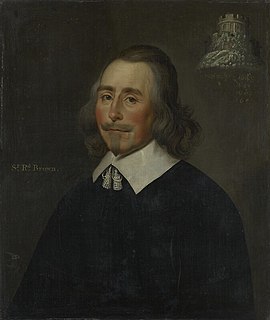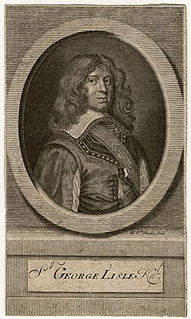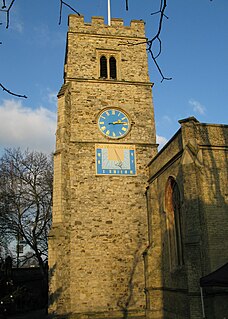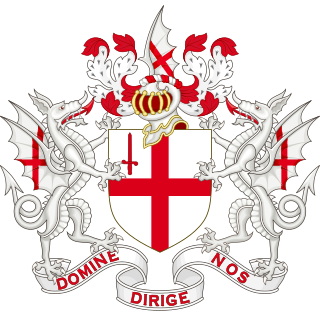The Battle of Lostwithiel took place over a 13-day period from 21 August to 2 September 1644, around the town of Lostwithiel and along the River Fowey valley in Cornwall during the First English Civil War. A Royalist army led by Charles I of England defeated a Parliamentarian force commanded by the Earl of Essex.

1643 (MDCXLIII) was a common year starting on Thursday of the Gregorian calendar and a common year starting on Sunday of the Julian calendar, the 1643rd year of the Common Era (CE) and Anno Domini (AD) designations, the 643rd year of the 2nd millennium, the 43rd year of the 17th century, and the 4th year of the 1640s decade. As of the start of 1643, the Gregorian calendar was 10 days ahead of the Julian calendar, which remained in localized use until 1923.
Year 1471 (MCDLXXI) was a common year starting on Tuesday of the Julian calendar.

1583 (MDLXXXIII) was a common year starting on Saturday of the Gregorian calendar and a common year starting on Tuesday of the Julian calendar, the 1583rd year of the Common Era (CE) and Anno Domini (AD) designations, the 583rd year of the 2nd millennium, the 83rd year of the 16th century, and the 4th year of the 1580s decade. As of the start of 1583, the Gregorian calendar was 10 days ahead of the Julian calendar, which remained in localized use until 1923.

William Russell, 1st Duke of Bedford KG PC was an English nobleman and politician who sat in the House of Commons from 1640 until 1641 when he inherited his Peerage as 5th Earl of Bedford and removed to the House of Lords. He fought in the Parliamentarian army and later defected to the Royalists during the English Civil War.
Sir James Harington, 3rd Baronet of Ridlington was an English Member of Parliament and a Parliamentarian commander during the English Civil War.

Sir Richard Browne, 1st Baronet was a London businessman who became a major-general in the Parliamentary army during the English Civil War, but opposed The Protectorate. He was subsequently Lord Mayor of London after the Stuart Restoration.

Sir George Lisle was a professional soldier from London who briefly served in the later stages of the Eighty and Thirty Years War, then fought for the Royalists during the Wars of the Three Kingdoms. Captured at Colchester in August 1648, he was condemned to death by a Parliamentarian court martial and executed by firing squad along with his colleague Charles Lucas.

Henry Bard, 1st Viscount Bellomont was a Royalist soldier and diplomat who served in the Wars of the Three Kingdoms, then as envoy from Charles II of England to Safavid Iran and the Mughal Empire, where he died in 1656.

Lord Bernard Stewart was a Franco-Scottish nobleman and a third cousin of King Charles I of England, both being descended in the male line from John Stewart, 3rd Earl of Lennox. He served as a Royalist commander in the English Civil War, during which he was killed aged 22 and unmarried.
The Eastern Association of counties was an administrative organisation set up by Parliament in the early years of the First English Civil War. Its main function was to finance and support an army which became a mainstay of the Parliamentarian military effort until early 1645, when many of its units were incorporated into the New Model Army.

Cornwall played a significant role in the English Civil War, being a Royalist enclave in the generally Parliamentarian south-west.
Thomas Parker (1595–1677) was an English nonconforming clergyman and a founder of Newbury, Massachusetts.

Colonel Nathaniel Rich was a member of the landed gentry from Essex, who sided with Parliament during the Wars of the Three Kingdoms and was "an example of those pious Puritan gentlemen who were inspired by the ideals of the English Revolution". Appointed a colonel in the New Model Army in 1645, then elected MP for Cirencester in 1648, he was a close associate of Oliver Cromwell until the two fell out due to his association with the Fifth Monarchists, a radical religious group that opposed the latter's appointment as Lord Protector in 1653.
Battlefields are the final resting place for thousands of unknown soldiers, both nobles and commoners, whose lives were sacrificed in the making of the history of their country. These historic assets are an intrinsic part of a nation’s identity and consciousness. They inspire strong emotions and live on in stories, poetry and music. However, the history relating to them is often hard to unravel, as there is often little to see above ground and the historical record is usually written by the victors. The UK has many historic battlefield sites, some of which have legal protection through heritage protection legislation whilst others are protected through landscape legislation. More recently, some archaeologists prefer the term "site of conflict" to "battlefield", because of the difficulty in defining the geographical extent of a site.

The siege of Chester occurred over a 16-month period between September 1644 and February 1646 during the First English Civil War. In the engagement, Sir William Brereton and the Parliamentarians were ultimately successful in taking possession of the city and Royalist garrison commanded by Lord Byron.

The London Trained Bands (LTBs) were a part-time military force in the City of London from 1559 until they were reconstituted as conventional Militia regiments in 1794. They were periodically embodied for home defence, for example in the army mustered at Tilbury during the Armada Campaign of 1588. They saw a great deal of active service during the English Civil War, including the First and Second Battles of Newbury, and the battles of Alton, Cheriton, Cropredy Bridge and Lostwithiel. Throughout their history they were used to suppress civil disorder and insurrection around the capital.
The Battle of Sherburn in Elmet was an action fought towards the end of the First English Civil War. A detachment of the English Royalist army led by Lord Digby, King Charles I's Secretary of State, was making a belated attempt to reach Scotland and join forces with the Scottish Royalists. As they moved north through Yorkshire, they were pursued by a Parliamentarian force under Sydnam Poyntz. Poyntz was unaware of the Royalists' position, and the Royalists took the opportunity to ambush and attack a small Parliamentarian detachment at night in the village of Sherburn in Elmet. However, the Royalists then mistook fleeing Parliamentarians for their own men and panicked. In the ensuing flight, several hundred Royalist prisoners were taken. The Parliamentarians also captured Digby's coach, which contained much compromising correspondence.
The Westminster Trained Bands were a part-time military force in the City of Westminster from 1572 until they were reconstituted as conventional Militia regiments in 1662. They were periodically embodied for home defence, for example during the Armada Campaign of 1588. They saw a great deal of active service during the English Civil War, including the battles of Alton, Cropredy Bridge, and Second Newbury, and Siege of Basing House. Throughout their history they were used to suppress civil disorder and insurrection around the palaces of Westminster and Whitehall.











